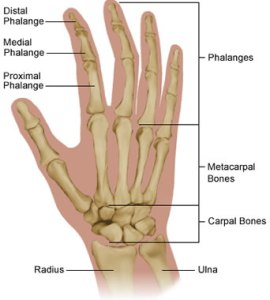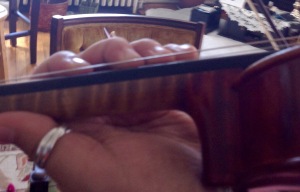by Rozanna Weinberger
A common theme regarding misconceptions in viola/violin technique has to do with how one overexertes certain muscles, and how to utilize natural principles to guide ones approach. For example, it is a common misconception that putting down the fingers of the left hand is reliant on force, and in many cases players will involve the entire hand including tension in thumb, wrist. While many players understand, at least in theory that there should not be excessive effort in the entire hand when playing, differentiating what is and isn’t needed, and what constitutes excessive effort, is a big challenge. Squeezing the fingers together including the thumb & index finger as well as the 4 fingers between index finger and pinky, are very common ways that players overexert themselves, leading to chronic pain.
The truth is, putting down a finger can and should rely on gravity for the natural momentum to drop fingers down onto the finger board. The natural weight of the fingers is more than enough exertion to depress the string. And yet players will typically squeeze and press the fingers while overexerting the thumb, typically in a squeezing of the neck between thumb & index finger.

Notice how fingers actually begin at the carpal bones, the part of the wrist that is so often overused with excessive tension. Assuming the angle of the fingers are appropriate to string, the Proximal Phalange portion of finger falls onto string from knuckle.
Simple isolation of squeezing thumb & index finger then relaxing helps player become more conscious of what tends to happen unconsciously. One can also put pencil between thumb & index finger then squeeze pencil & release. The squeezing action in relation to the pencil is what typically happens with neck of violin when players over exert left hand. The ability to differentiate relaxation & tension in this part of the hand will ultimately help player consciously relax parts of hand that are too tense and to weed out exertion in parts of hand where none is actually needed. Over time the brain & kinesthetic learning kicks in and the body eventually does what is most natural with minimum effort.
If we can understand that due to gravity the fingers are able to ‘fall’ from the knuckle to the string, then it begins to make sense that most the exertion in the left hand happens when elevating fingers after note is played. Further, the placement of the thumb under the neck of the viola/ violin enables the hand to come around sufficiently so fingers are at an angle to drop onto the string from the knuckles. A simple motion study I call flapping is a great motion study to get the right ‘feel’ in the left hand.
Keeping fingers unbent, simply drop the fingers from the knuckle and flap fingers onto the fingerboard then raise the fingers off the finger board as quickly as possible, as if the finger board were super hot . Notice the effort involved in raising the fingers against the forces of gravity, yet how easy it feels to let the fingers drop onto the fingerboard. (Special thanks to Rosanne Vandemark, my hand model.)

When practicing the Fwapping player can begin with totally straight fingers, allowing fingers to drop from knuckle then quickly raise them off string as if fingerboard was burning hot. Then the study can be modified with fingers slightly curled, more closely resembling how one would normally play.
When fingers are balanced on fingerboard the weight of finger is all the momentum needed to depress string sufficiently.

